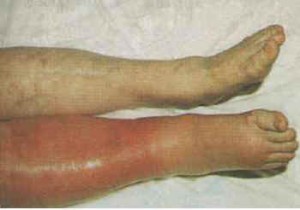There are a lot of people who have had deep vein thrombosis, with absolutely no idea what they are or if they were even at risk. There are certain common medications that put you at risk, lifestyle choices, etc and they can be quite devastating. So let’s get to the bottom line of what DVTs are, how they occur, treatments, and risk factors.
What is a DVT?
It is blood clot (aka thrombus) that forms in one of the deeper veins of your body, usually in your legs, can occur without any symptoms, and can then break free and travel to your brain, lungs, or heart causing a pulmonary embolism, stroke, or heart attack (due to a lack of blood flow to major areas from the clots). Almost half of all DVT’s form without any symptoms, which can be pretty scary.
What are the symptoms?
Despite the fact that DVTs can be silent (or symptomless) there are some symptoms that people can have:
-Swelling in the affected leg (calf, ankle, foot)
-Pain in your leg (or ankle/foot) that feels like a charlie horse or muscle cramp
-Warmth or redness in the affected area
Why do they form?
There are tons of reasons for these clots to occur, some are as simple as having a family history of clotting disorders, having surgery, or women who take birth control and smoke. But there are a whole slew of other reasons that you could form a deep vein thrombosis: sitting for long periods of time driving or flying, prolonged bed rest (like when sick or in the hospital), injury to your veins, pregnancy (increased pressure on your veins along with hormonal changes), cancer, heart failure, pacemakers, intravenous lines (like when in the hospital), inflammatory bowel disease, family history or a prior DVT, being overweight, smoking, and tall men. Yikes! There are tons of reasons that they form, but the important thing is to be aware of your family history, and the other risk factors, so that if there is anything you can alter (i.e. lose weight or stop smoking) you can, and if not, you can just be aware of what to look for.
How are DVTs diagnosed?
When you are suspected of having a DVT, there are a few tests that may be performed to diagnose the actual clot. Your HCP will take some blood and test your clotting factors to see if they are elevated (you may be at a higher risk to clot) and they will also check a D-dimer, if you have a clot, your D dimer will most likely be elevated because it is a naturally occurring clot busting substance in the blood. You may also have an ultrasound to visualize the clot, in the area assume to be affected. If there is a suspected clot that may have moved, your HCP may send you for a CT Scan or an MRI that may help to visualize the clot. They can also do a venography, in which they shoot die into the vein to try to visualize the clot, but it is a lesser used method for diagnosis of DVT.
How do I treat a DVT?
The goal is to diminish the clot, prevent more form forming, and if you can’t get rid of it, prevent it from doing some major damage (like the aforementioned pulmonary embolism, stroke, heart attack). The usual treatments are blood thinners that prevent your blood clot from getting any bigger and prevent new ones from forming, like heparin (which is injected or in intravenous form) and then coumadin (oral form). Just remember, if you are taking coumadin (which is actually rat poison) you need to be careful about eating foods high in vitamin K (like green leafy vegetables) as Vitamin K can reverse the effects of coumadin. If your clot has progressed and might cause a pulmonary embolism, you may get a clot busting drug called tPA (tissue plasminogen activator), it is given through an IV but you need a lot of monitoring and need to be in the hospital as there are high risks of bleeding after getting the medication. And, if the clots cannot be treated with the medications, due to side effects, then you may have a filter placed in your large veins; if the clots break off and travel, they will get caught in the filter and they will be unable to travel up an cause any other damage.
How to I prevent DVTs?
Keep active, lay off the smokes (especially if you are on birth control), try to live a healthy lifestyle, and being aware of the risks is the best for of prevention; if you know the risks, you can talk to your HCP if you have risk factors to come up with a prevention plan and/or just keep the conversation open so they can be aware and let you know what you can do to further prevent your risks. You can also wear compression stockings when on your feet for long periods of time, they help to keep veins constricted so that your blood cannot pool and clot AND it helps to prevent swelling of your legs. Also make sure to exercise your lower calf muscles, watch your vitamin K, and make healthy lifestyle choices like eat healthy and exercise.
Be aware of the risks, keep the symptoms in the back of your mind, and if you think you have a DVT, go see your HCP or to the ED immediately for treatment.
Yours in Good Health
B


